
This is the seventh in a series of posts exploring infinity, entities and ideas infinite, infinities larger than other infinities, infinity paradoxes, infinite perimeters, infinite regress and infinite sequences such as cyclic numbers.
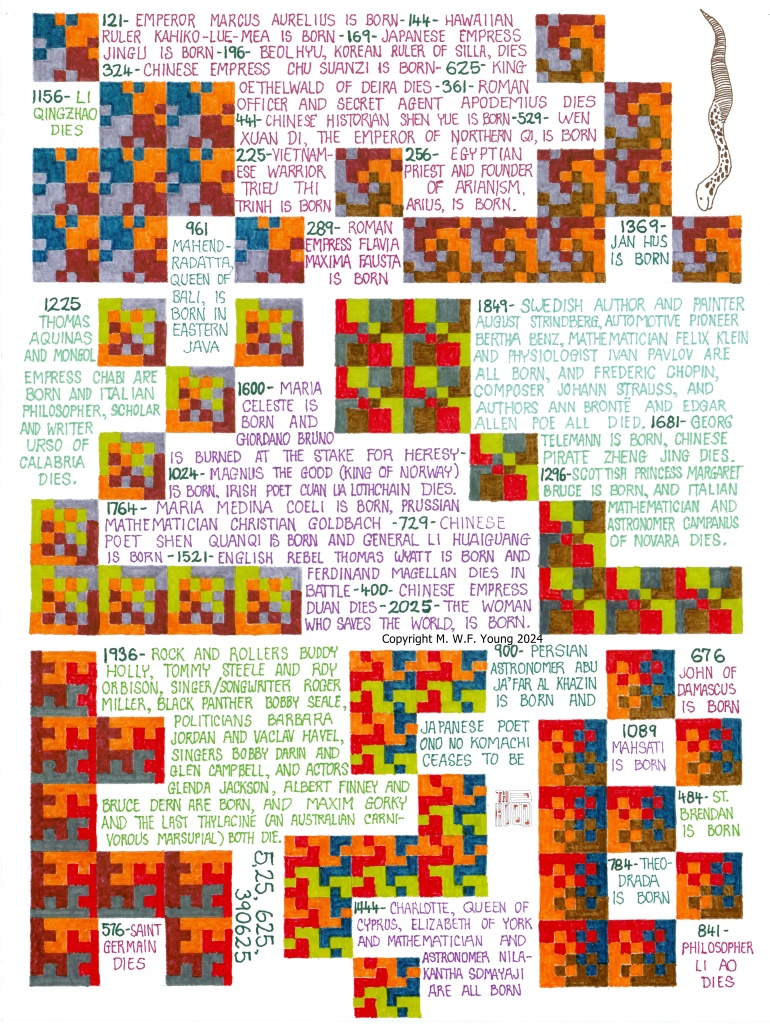
This is also the second in a series of posts about replicating tiles, or rep-tiles for short. Some rep-tiles are quite boring but some are very interesting. A rep-tile is a shape (e.g. a square) which can be divided into smaller shapes all of which are identical in shape to the figure you started with. Those identical smaller shapes are also all the same size. For more details see the first post in this series on rep-tiles.
There are seven rep-tiles in the illustration above. For example, take a look at the figure on the left at the top.
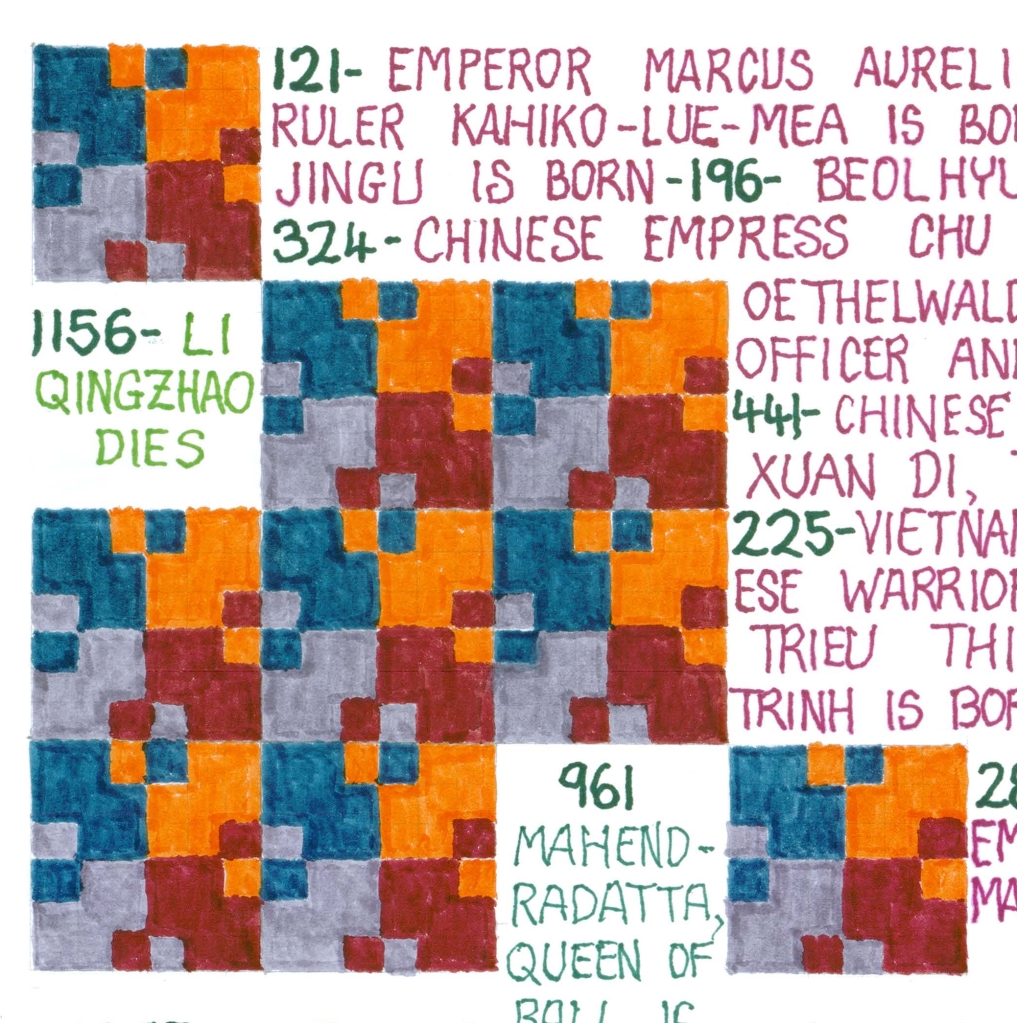
The overall large figure consists of nine squares, each of those squares consists of four smaller shapes (blue, orange, grey and brown), and each of those smaller shapes is identical in shape to the large overall shape you started with. You have thirty-six (9 x 4) of the smaller shapes inside the large shape. Not only that, but all thirty-six smaller shapes are all the same size. This large shape is a rep-tile.

THE TRIAL OF GIORDANO BRUNO
By Jastrow – Self-photographed, Public Domain, https://commons.wikimedia.org/w/index.php?curid=1193142
All seven rep-tiles here consist of nine squares and each square is divided up into four smaller shapes. The text consists of historical dates and events that happened during each year listed. For example, the Roman emperor Marcus Aurelius was born in 121 CE. In 1600 Dominican friar and later cosmologist Giordano Bruno is burned at the stake for heresy. He had insisted that the universe was infinite and therefore could have no centre. He also rejected the afterlife, the Trinity and other central church doctrines. The entry under the date 2025 is speculative.
With these rep-tiles we have squares made up of small rep-tiles and large rep-tiles made up of squares – squareness is the name of the game. Have you guessed the significance of all these dates / numbers? The dates / numbers are themselves perfect squares: 121 = 11 x 11. 1600 = 40 x 40. 1936 = 44 x 44 and so on. You might want to test your number sense by going through and trying to guess what the square root of each date / number is.
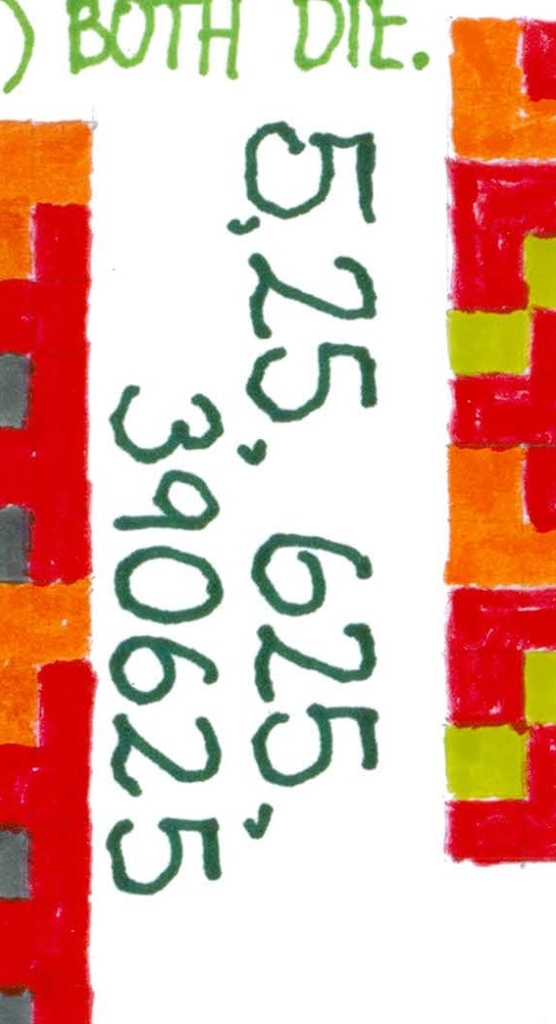
Did you also notice the four numbers at the bottom without text – 5, 25, 625, 390625? It seems that if you square 5 you get 25 and the last digit of 25 is 5. If you square 25 you get 625 and the last two digits of 625 are 25. If you square 625 you get 390625, and the last three digits of 390625 are 625.
SPHINX
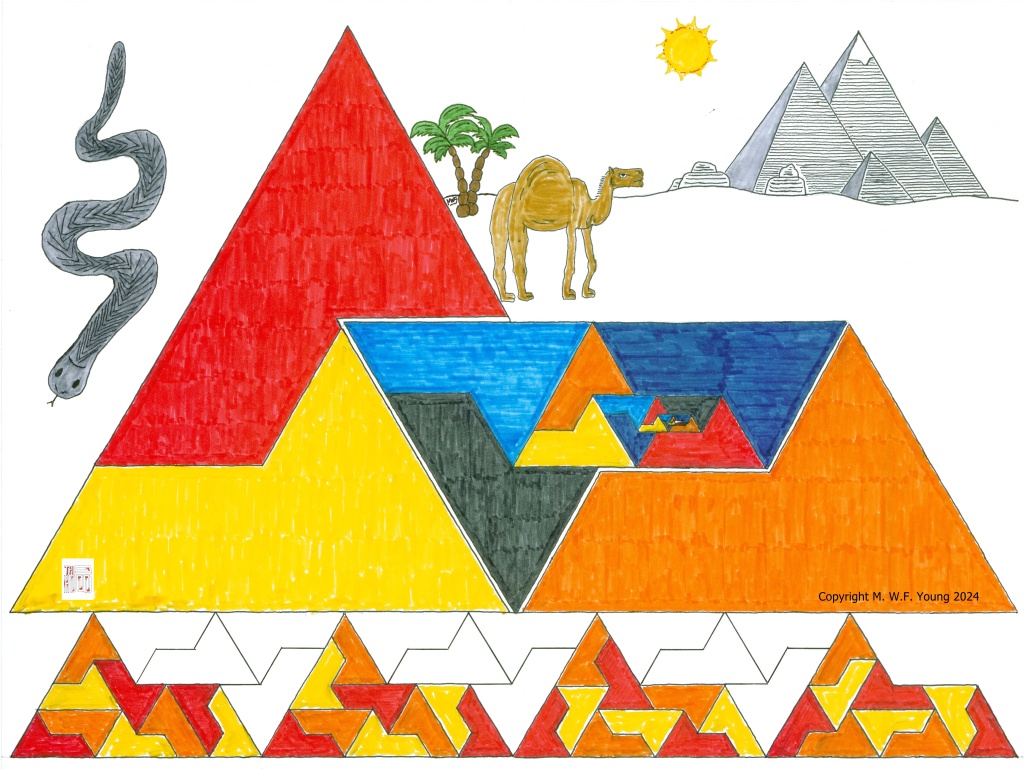
There is also something called an IRREP-TILE which is an IRREGULAR REPLICATING TILE. An irrep-tile, like a rep-tile, is a shape which can be subdivided into smaller shapes all of which are identical to the large shape you started with. However, those smaller shapes are not all the same size. In the illustration above, featuring a shape which mathematicians refer to as The Sphinx, you can see four rep-tiles at the bottom which are four different ways in which the sphinx shape can be subdivided into nine identical smaller sphinxes.
However, every rep-tile, not just this one, can be turned into an irrep-tile, as illustrated by the main figure in this illustration. In this main figure one can see that the Sphinx has been subdivided into four smaller sphinxes, separated here by thin white lines. However, any one of those four (in this case the darkest one) can be subdivided into four smaller sphinxes, and any or all of those four smaller ones can be subdivided further, and so on forever until the shapes are infinitesimally small.
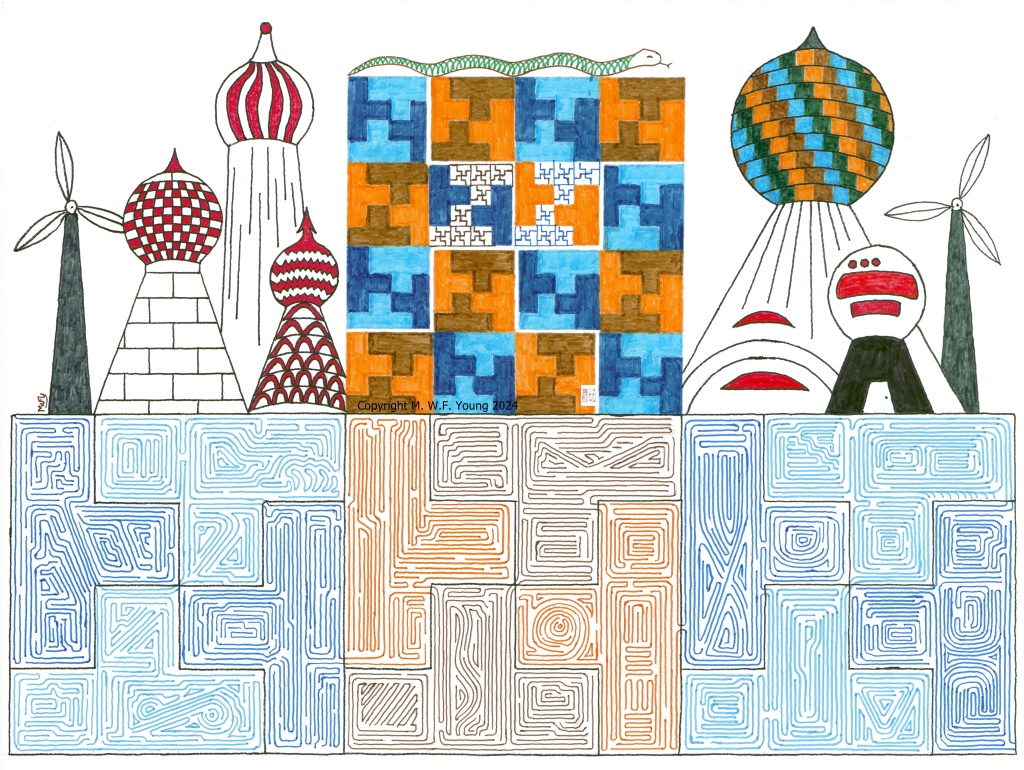
This is my illustration of another irrep-tile. I started with a configuration of four squares in the shape of a sort of stubby upside-down T shape. Each one of those four squares can be subdivided into four smaller T-shapes identical to the original large T-shape. The T-shape, treated as a rep-tile, can therefore be subdivided into sixteen smaller shapes identical to the original and all the same size. I’ve subdivided just the three bottom squares each into four smaller T-shapes, each one in the form of part of a maze:
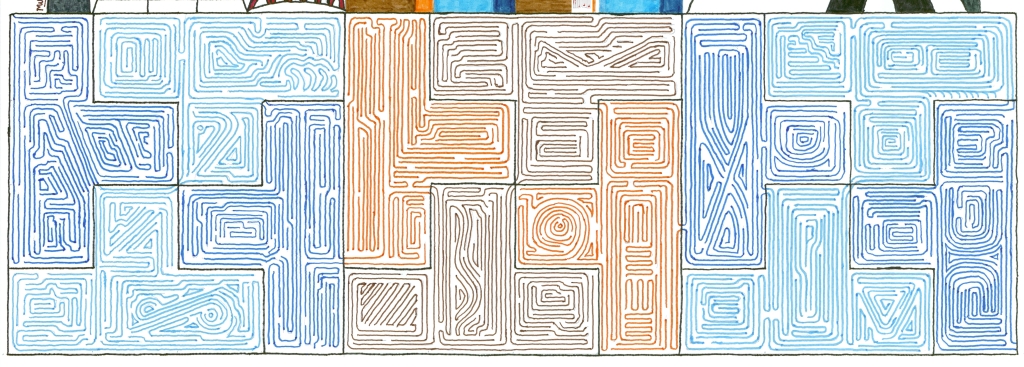
By the way this maze is a legitimate maze, with an entrance and an exit and a way to get from one to the other. I also subdivided the fourth square, at the top, into four smaller T-shapes (divided by thin white lines):

However in this case I subdivided two of those four T-shapes (at the bottom and on the right) into sixteen smaller T-shapes – in the bottom case two dark blue, two light blue, six brown and six orange T-shapes, and in the case on the right six dark blue, six light blue, two brown and two orange T-shapes.
In the case of the last two T-shapes (on the left and at the top) in the square at the top, in each case I subdivided the T-shape into fourteen smaller T-shapes plus two other T-shapes each of which has been subdivided further into sixteen white T-shapes.
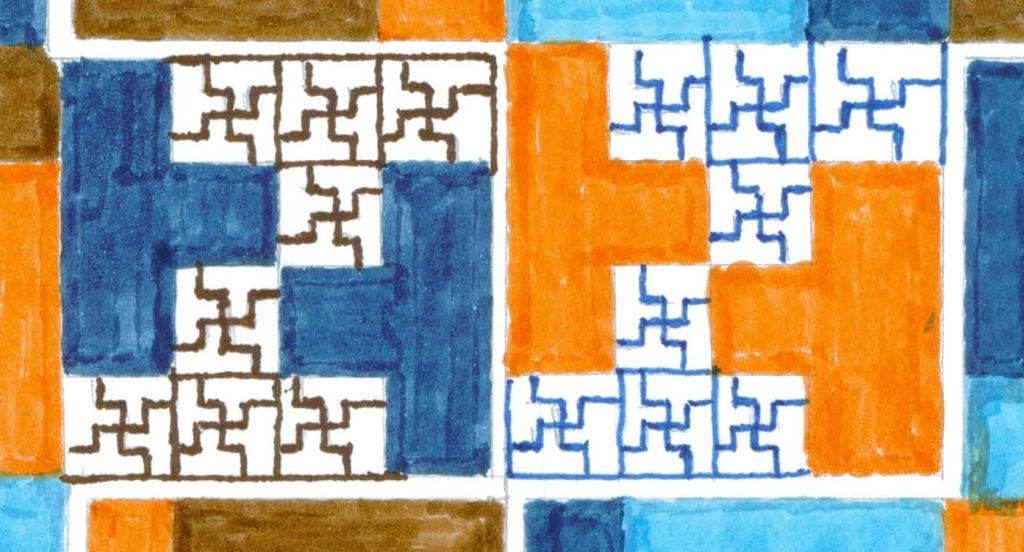
I could have kept subdividing forever until the shapes were infinitesimally small. On the other hand I could have just divided the original large inverted T-shape into sixteen smaller T-shapes in the form of one large maze.
NEXT POST: Welcome To The Rep-Tile House Part 3
- Post 1 – https://thekiddca.wordpress.com/2024/04/06/infinities-infinity-everywhere/
- Post 2 – https://thekiddca.wordpress.com/2024/04/13/infinities-2-theres-no-business-like-snow-business/
- Post 3 – https://thekiddca.wordpress.com/2024/04/20/infinities-3-infinitesimal-chi-chiao-tu/
- Post 4 – https://thekiddca.wordpress.com/2024/04/27/infinities-4-no-vacancies-but-rooms-still-available-at-hotel-infinity/
- Post 5 – https://thekiddca.wordpress.com/2024/05/04/infinities-5-pythagorean-infinity/
- Post 6 – https://thekiddca.wordpress.com/2024/05/12/infinities-6-welcome-to-the-rep-tile-house-part-1-of-5/
4 thoughts on “INFINITIES 7 – Welcome to the Rep-tile House Part 2 of 5”